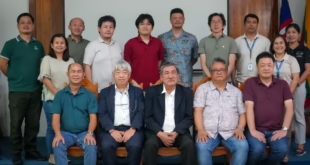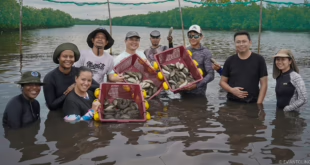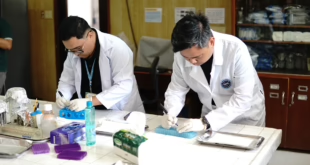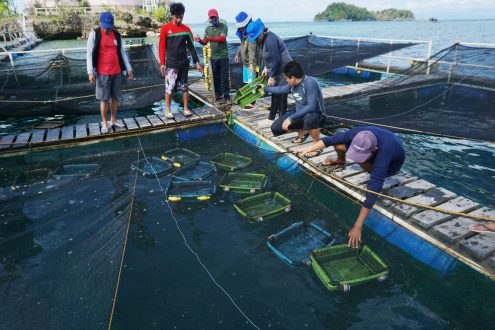
To “intensely” address the problem on the shortage of quality seed material (propagules) and increase productivity and profitability within the seaweed sector, technical staff of the Philippine Bureau of Fisheries and Aquatic Resources (BFAR) attended a 10-day training course at SEAFDEC/AQD.
The training course on micropropagation and nursery operations of the seaweed Kappaphycus was held on 26 November to 5 December 2018 and was attended by nine technical staff assigned in BFAR-operated Seaweed Culture Laboratories (SCLs). The training included lectures and practical activities on seaweed biology, ecology, culture and farming economics.
“We are aiming to produce more seaweeds for Region 6 through micropropagation. We were sent here in SEAFDEC because we are going to use their technology and apply in our laboratory to produce more seaweeds,” said Ms. Jhonamer Descalsota, one of the nine technical staff from BFAR who attended the training.
Micropropagation is a technique used at SEAFDEC/AQD to mass-produce seaweed plantlets that, under the right conditions, grow faster and are more disease-resistant than the traditional seaweed cuttings.
“Through micropropagation, we can come up with a solution regarding the decline of the stocks. From this technology that the SEAFDEC introduced to us, we can assure that we can deliver well-nourished and new plantlets for a new generation of the seaweeds industry of the Philippines,” said Mr. Muhaimin Maharail, regional seaweeds coordinator of BFAR Region 9.
Meeting production targets
Mr. Dennis Brylle Balamabao from BFAR CARAGA Region shared how the training can help solve the problem on their laboratory’s low seaweed production.
“Because of this training, I think, we’ll be guided on what to do to meet our target production; at the same time, this training will also lead us to reach out to the farmers and provide them with good quality seaweed propagules from the laboratory,” Balamabao said.
“We learned a lot from the history to the trends, the status, problems to be encountered, as well as future aspects. SEAFDEC is very good at accommodating us; they have shared their technologies so that our regions can give the production that the country needs, increasing the capability of every regional office,” Mr. Phillip John Foronda from BFAR Region 1 stated.
Meanwhile, Maharail said that while their region is the third highest producer of seaweeds in the Philippines, most of their production still comes from natural growth. As for seaweed farming, it is still in its infancy and needs further development.
“The seaweeds production [in Region 9] is highly dependent on natural growth and sometimes this cannot sustain the needs of the region. Luckily, SEAFDEC enjoined the BFAR technicals to be trained here in SEAFDEC so we acquired the knowledge from the laboratory starting from micropropagation until the sea-based state. For our region, it is beneficial, and the technology is very efficient,” Maharail added.
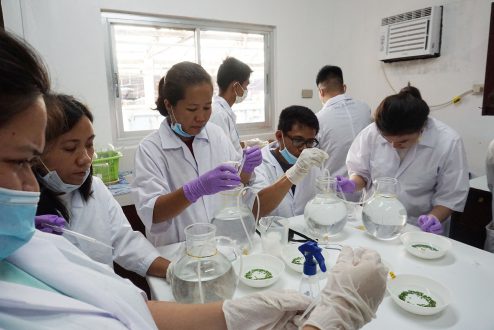
Future plans
“For our future plans, BFAR shall continuously operate the SCLs in close coordination with SEAFDEC to produce propagules of high quality and quantity for nursery cultivation and/or distribution to requesting clients. BFAR shall also develop a 3-year capability program for SCL personnel that we may sustain the operation of the laboratories,” Ms. Ida T. Capacio, Center Chief OIC of BFAR National Seaweeds Technology Development Center (NSTDC), informed.
Last year, the Philippine Department of Agriculture (DA) through BFAR started work on a National Seaweed Program to put the country back as the world’s leading producer of seaweeds. According to BFAR, it aims to improve seaweed production by at least five percent annually from 2017-2022.
Other training course participants were Paul John Paguergan from BFAR National Seaweeds Technology Development Center (BFAR – NSTDC); Fariza Haron from BFAR –ARMM Region; Rebecca Rama from BFAR Region 8; Gemma Alipar from BFAR Region 5; and Johnrey Antipaso from BFAR Region 2.
 SEAFDEC/AQD Southeast Asian Fisheries Development Center | Aquaculture Department
SEAFDEC/AQD Southeast Asian Fisheries Development Center | Aquaculture Department
